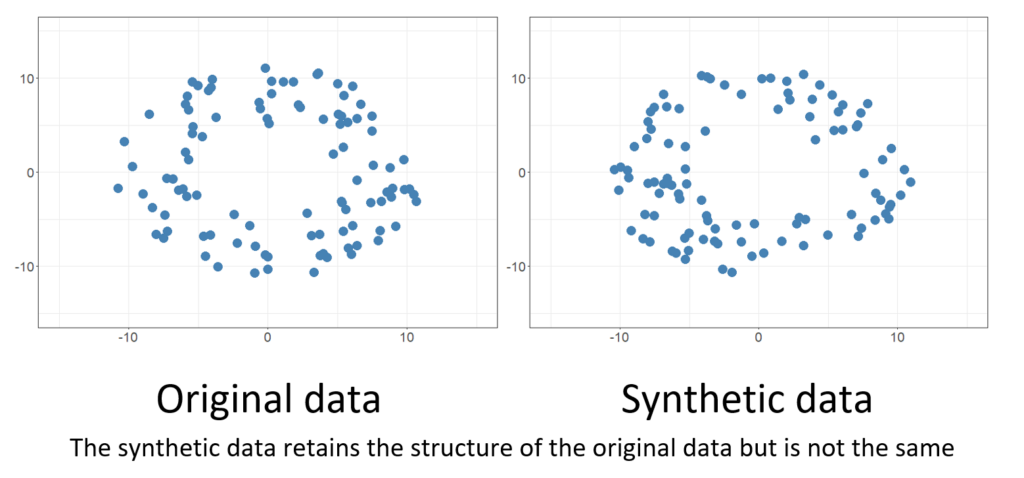What is Synthetic Data?
In a data-driven world, knowledge is power, but acquiring and handling real-world data isn't always straightforward. That's where synthetic data comes into play. Synthetic data is computer-generated data that mirrors the characteristics and patterns of real-world data, without containing any actual confidential or sensitive information—a groundbreaking concept in data science and artificial intelligence.

Why Synthetic Data?
Data Privacy and Security
Synthetic data offers numerous advantages that can transform the way you work with data. Unlike real data, synthetic data is designed to be privacy-friendly (through differential privacy) and shareable without concerns (it is a GDPR-compliant method to be able to do so).
Advanced Flexibility
Synthetic data generation tools provide unmatched flexibility, allowing you to shape data to your needs. Whether you need to reduce large datasets for manageability, expand small datasets for rigorous stress tests, balance minority class representation for accurate machine learning models, simulate data by altering distributions, or fill in missing data with realistic points, synthetic data offers limitless possibilities.
Simply Smarter
Real data can have many limitations, but synthetic data is a smarter choice. While traditional data anonymization techniques compromise utility and intelligence, synthetic data generation strikes the perfect balance between privacy and utility. Synthetic data empowers you to create countless unique profiles, test software, and uncover hidden edge cases, making it a genuinely intelligent alternative to traditional data.
Use Cases of Synthetic Data

Facilitating Data Sharing and Collaboration
Synthetic data acts as a catalyst for data sharing and collaboration among organizations. In scenarios where sharing actual data raises privacy and security concerns, synthetic data provides a secure alternative. By generating data that effectively mimics real-world statistics, organizations can freely exchange insights, fostering collaboration in research projects and industries where data sharing is paramount/crucial but sensitive/regulated (GDPR/HIPAA Compliance, for example).
AI/ML Model Development
Synthetic training data is a transformative solution for AI and ML development, addressing scarcity and privacy concerns. It enhances data by upscaling rare patterns, mitigating biases, and boosting AI performance. This data also facilitates injecting/infusing domain knowledge into models and forms the foundation for Explainable AI, offering insights into model decisions. In contrast to traditional limitations due to data scarcity, synthetic data provides a path toward more intelligent and inclusive AI development.


Testing and Product Development
Synthetic test data can drastically improve software testing, by streamlining development, reducing cycle times, and ensuring privacy compliance. In complex enterprise settings, obtaining realistic data is often hindered by anonymization tools, schema limitations, and prohibitions against using production data. Synthetic test data offers a practical solution, creating realistic, privacy-compliant replicas of customer data, expediting development and reducing costs.
Improving AI/ML Fairness and Explainability
Fair AI and explainability are critical in AI/ML development, an industry which oftentimes grapples with issues like pervasive biases and opacity. An alarming 85% of algorithms exhibit bias, affecting both financial and social aspects, such as hiring and credit scoring (Gartner). Global AI regulations, like the EU’s initiative, underscore the need for fairness and transparency, yet organizations struggle to demonstrate compliance—implementing Fair and Explainable AI remains a complex work in progress. Synthetic data offers promise, effectively addressing bias in datasets, enhancing fairness, and providing an audit trail for transparent AI decisions, pivotal in gaining trust and meeting regulatory standards while maintaining privacy compliance.

How We Approach Synthetic Data Generation
At Crowdruption, we employ cutting-edge techniques to craft high-quality synthetic data that meets the rigorous demands of AI and machine learning applications. Our differentiator? Generative Adversarial Networks (GANs) and Variational Autoencoders (VAEs).
Generative Adversarial Networks (GANs)
GANs are at the heart of our synthetic data generation process. GANs consist of two neural networks – a generator and a discriminator – continuously engaged in a competition. The generator strives to produce data that is indistinguishable from real-world data, while the discriminator diligently assesses its authenticity. This adversarial training results in a dynamic feedback loop that pushes the generator to continually refine its creations. The outcome? Synthetic data that not only mimics the statistical properties of real data but also exhibits the nuances and complexities essential for training AI models effectively.
Variational Autoencoders (VAEs)
Complementing GANs, Variational Autoencoders (VAEs) play a crucial role in our synthetic data generation pipeline. VAEs excel at capturing the underlying structure and distribution of data. They do so by learning a compact representation, or latent space, where data can be manipulated and generated with precision. VAEs allow us to generate synthetic data that adheres not only to the statistical patterns but also the finer-grained features and relationships present in real data. This level of fidelity is essential for training AI models that generalize well and excel in real-world scenarios.





 Raj Mehta – Certified Financial Education Instructor (CFEI)
Raj Mehta – Certified Financial Education Instructor (CFEI)

